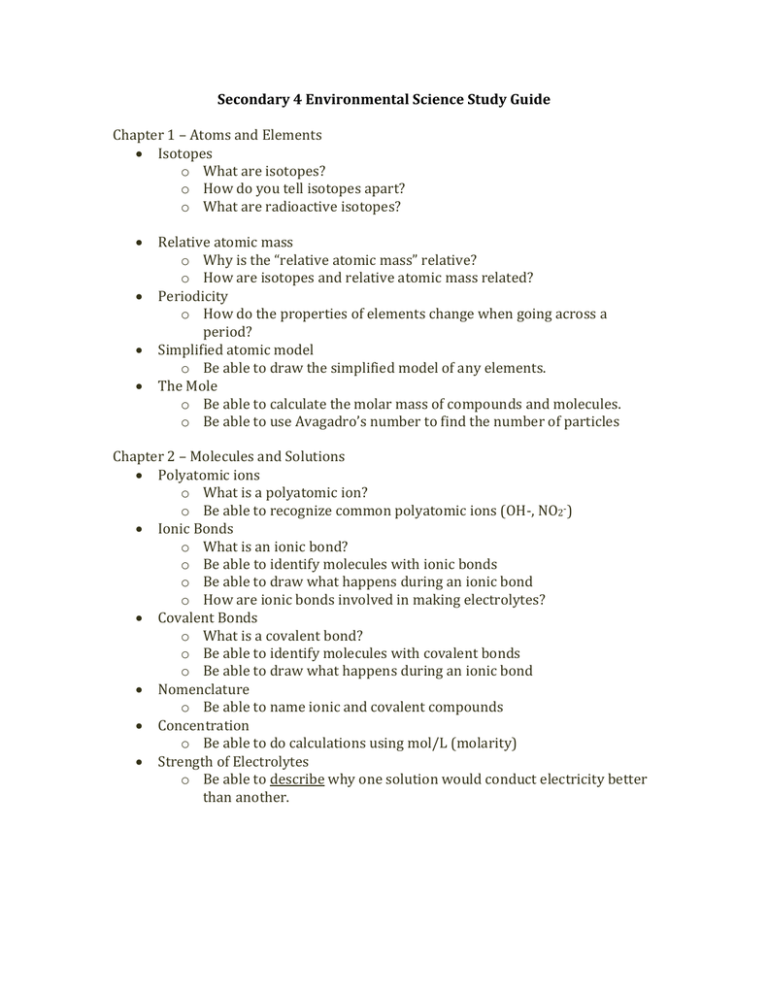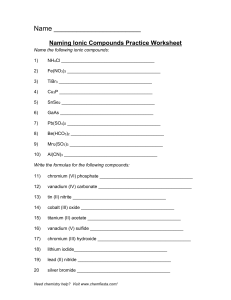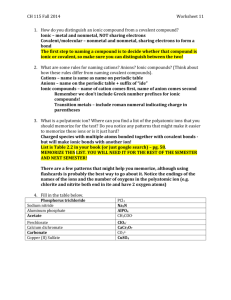Study Guide EST - Westmount High School
advertisement

Secondary 4 Environmental Science Study Guide Chapter 1 – Atoms and Elements Isotopes o What are isotopes? o How do you tell isotopes apart? o What are radioactive isotopes? Relative atomic mass o Why is the “relative atomic mass” relative? o How are isotopes and relative atomic mass related? Periodicity o How do the properties of elements change when going across a period? Simplified atomic model o Be able to draw the simplified model of any elements. The Mole o Be able to calculate the molar mass of compounds and molecules. o Be able to use Avagadro’s number to find the number of particles Chapter 2 – Molecules and Solutions Polyatomic ions o What is a polyatomic ion? o Be able to recognize common polyatomic ions (OH-, NO2-) Ionic Bonds o What is an ionic bond? o Be able to identify molecules with ionic bonds o Be able to draw what happens during an ionic bond o How are ionic bonds involved in making electrolytes? Covalent Bonds o What is a covalent bond? o Be able to identify molecules with covalent bonds o Be able to draw what happens during an ionic bond Nomenclature o Be able to name ionic and covalent compounds Concentration o Be able to do calculations using mol/L (molarity) Strength of Electrolytes o Be able to describe why one solution would conduct electricity better than another. Chapter 3 – Forms of Energy Thermal Energy o What does “specific heat capacity” mean? o How would you determine the specific heat capacity of a substance? o How is the specific heat capacity related to heat, mass and temperature? o Be able to use the formula ΔE = Q = mcΔT Potential Energy o What is potential energy? o What is gravitational potential energy? o How is gravitational potential energy related to mass, gravitational pull and distance travelled? o Be able to use the formula Ep = mgh Kinetic Energy o What is kinetic energy? o How is kinetic energy related to mass and speed? o Be able to use the formula Ek = 1⁄2mv2 Effective force o What is the effective force? o Be able to use the formula W = FΔd o Be able to use trigonometry to find the effective force o How is the force applied on an object related to the distance travelled by the object and the work done? o Be able to use the formula W = FΔd Mass and Weight o How are mass and weight related o What is mass? o What is weight? o Be able to use the formula Fg=mg Work and Energy o How are energy and work related? o Be able to use the formula W=ΔE Chapter 4 – Changes in Matter Oxidation Reactions o Be able to recognize an oxidation reaction from a group of reactions Neutralization Reactions o Be able to figure out the molecular formula of the salt made by an acid-base neutralization Stoichiometry o Make sure you do practice questions to find the amount of reactants or products in grams or moles Endothermic and exothermic reactions o Be able to choose between endothermic and exothermic reactions according to where the “energy” term is written in the equation or by signs of the chemical reactions (changes in temperature, light, etc.) Nuclear Stability o What is nuclear stability o How does the nucleus of an atom stay together even with all the positive charges repelling eachother? Radioactivity o What is radioactivity? o What particles are involved with radiation o What are some beneficial uses of radiation? o What is the difference between fusion and fission? Chapter 5 Kirchhoff’s laws o Make sure you can describe Kirchoff’s Laws in words, and be able to use the laws to describe how current, voltage, and resistance change in series and parallel circuits. o You should be able to find Req in a parallel circuit o You should be able to solve circuit problems using ohm’s law and Req Coulomb’s law o You should be able to use the F = kq1q2/r2 equation in a problem o How is the electrical force related to the magnitude of the charges? Magnetic Field of a solenoid (coiled wire) o Use the right hand rule to draw the magnetic field of the solenoid o How do you change the strength of the magnetic field in a solenoid? o What uses do we have for solenoids? Chapter 6 – Lithosphere and Hydrosphere Soil depletion o What is soil depletion? o How do humans affect soil depletion? Buffering Capacity o What is soil buffering capacity? Contamination o What are some examples of water contaminants? Eutrophication o What are the steps involved in the eutrophication of a body of water? o How do humans accelerate eutrophication? Chapter 7 – Atmosphere and Space How do prevailing winds affect the distribution of pollution in the air in a given region? Chapter 8 – The Biosphere Phosphorous cycle o What are the forms of phosphorus (different molecule carriers of phosphorus) and processes involved in the phosphorous cycle? Chapter 9 – Populations and communities All material is covered by the ST portion of the course, you should know it, but it won’t likely show up on your EST test Chapter 10 – Ecosystems Ecological footprint o What does an ecological footprint describe? o Note: ***An ecological footprint can be considered for an individual, groups of individuals, or larger groupings (companies, farms, countries, etc…) Ecotoxicology o What is ecotoxicology? o What are contaminants? o What are examples of physical, chemical, or biological contaminants in an environment? Bioaccumulation o What is bioaccumulation? o What is biomagnification (bioamplification)? o How does the concentration of a contaminant change through a food chain? Toxicity threshold o What is a toxicity threshold? o How is a toxicity threshold related to lethal dosage? o What factors affect the toxicity of contaminant? Chapter 11 - Genetics Heredity o What is heredity? o What are genes? o What is the composition of a DNA molecule? Allele o What is an allele? o What is the difference between homozygous and heterozygous? o What is a phenotype? o What is a genotype? o Be able to determine the results of breeding animals or plants Protein synthesis o How do we get from the code in a DNA molecule to a sequence of amino acids? o What are transcription and translation? Technology Chapters 12-14 *** Remember that only 10% of the test is on Tech, use your time wisely*** Exploded Views o Make sure you can read a technical drawing of an exploded view o Be able to explain what the exploded view is used for Dimensional Tolerance o What is a dimensional tolerance? Degrees of freedom o Why would we want to limit the motion of an object (for example, why do some doors open in both directions, but other doors can only be pulled or pushed? Adhesion and friction o Can you explain what the benefits or disadvantages are of having friction and adhesion occur in your object? Motion transformation systems o For the ST exam you need to recognize which transformation system is being used, for the EST exam you should be able to explain WHY you would choose one system over another (for example … most car jacks use a screw gear system rather than a rack-and-pinion system, because the force of the arm on the small crank provides more thrust and because, given that it is nonreversible, the system is safer) Power supply o What is the power supply in a manufactured object? o You should be able to name and describe the source of electrical current when you are shown an object. Conduction o What is conduction and insulation? o You should be able to choose between the insulators and conductors in a machine o What are fuses and breakers used for in machines or circuits? o Use the color codes of resistors to find the resistance of a resistor Technical drawing including circuits o Describe the type of switches in circuits (unipolar vs bipolar, and unidirectional vs bidirectional) o Describe the different energy transformations that occur in a circuit. (Electrical to light and thermal in a lightbulb, or electrical to sound in a speaker, etc..) o Describe energy transformations in electrical machines (phones, flashlights, etc… ) Heat Treatments o How does a heat treatment affect the properties of the material? Shaping materials o What shaping processes would you use with certain materials? o If you are given an object, can you determine what shaping technique was used? o What does “laying out” mean? o What does laying out have to do with materials and shaping ? o What tools are needed for shaping techniques? What is direct measurement? o What instruments are used in direct measurement? o Why would you choose one instrument over another? BIOTECHNOLOGY Cloning o What is cloning? o What are the consequences cloning (good and bad)? Wastewater treatment o How is water treated to remove contaminants? Biodegradation of pollutants o How are organisms used to degrade pollutants? ***** Reading pages 488-511 is HIGHLY recommended*****



